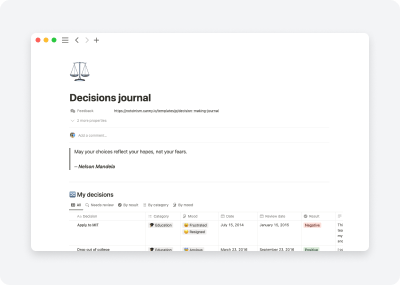Decision making journal and tracker template
We are the product of our decisions. The place we each find ourselves in life is the result of a series of choices we have made over the years. If we want to take a different path, we need to review our decision-making process. To do this, we must first gather data to make an informed decision. That's where a decision journal comes in.

Tracking our decisions is key to staying mindful of the choices we make and reflecting on the outcomes. Writing down our important decisions helps us create a record of our thought processes and the results of our decisions. This can help us recognize patterns of behaviour, identify areas for improvement and better understand our own decision-making process. Keeping track of our decisions also gives us a chance to review our successes and failures, so we can become better at making decisions in the future.
No more delay - let's take a look at how to use this decision tracker template for Notion.
How the Template Works
- Create a new record for a decision you've taken or are about to take.
- Fill in the context of the situation:
- Save the date when the decision was taken.
- Select a review date when this decision needs to be assessed. The time frame may vary for different decisions.
- When the review date arrives, go back to the decision and evaluate how it went:
- Archive the decision if there is no work pending, or reschedule the next review date if you want to wait longer.
Decision-Making Page Template
Before tracking the results, a decision has to be made. This is often a difficult process, so we've included a 🔀 Decision-Making Matrix to help you come up with a solution.
Here are the steps:
- Apply the Decision Template for the page.
- Describe the options you have.
- Create criteria to evaluate the options.
- Rank the options from 1 (worst) to 5 (best).
Once it’s done, you will have more tools at your disposal to make the right choice:
- Average score by option
- Progress bar for criteria
Neither of these numbers will give you a clear answer on which option is the best, but they certainly bring more clarity through simple visualization.
Structure
This template pretty simple. It includes two databases, several views, and a template for a single decision page.
Decisions database

It’s a main tool you’ll interact with. It has 5 views serving different purposes
- All - master view to see all your decisions sorted by date
- Needs review - decisions that you need to evaluate according to the Review dat
- By result - positive and negative decisions grouped to find decision-making patterns
- By category - groups by different aspects of your life (Сareer, Family, etc.)
- By mood - to see how your mental and physical condition impacts the outcome
Properties manual
⚖️ Decisions
Property |
Type |
Description |
|---|---|---|
| Criteria | Relation | Related criteria from Decision-making matrix |
| Archive | Checkbox | Check it when you’ve finished analysing your decision |
| Summary | Text | A brief conclusion on what happened and why |
| Result | Select | Whether your decision had positive or negative outcome |
| Review date | Date | Date when you want to come back and evaluate your choice |
| Date | Date | Date when decision is taken |
| Mood | Multi-select | How did you fell making this decision? |
| Category | Select | A sphere of your life the decision affects |
| Decision | Text | Name of your decision - what option you’ve chosen |
🔀 Decision-making matrix
Property |
Type |
Description |
|---|---|---|
| Option 1-5 | Number | Score of a option by criteria: 1 is worst, 5 is best |
| Decision | Relation | A decision this criteria refers to in Decisions database |
| Criteria | Text | A name of criteria. Formulate in such a way that 5 is always the best option |
